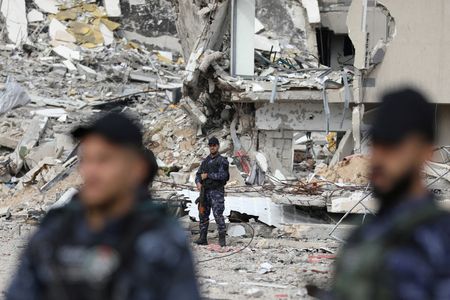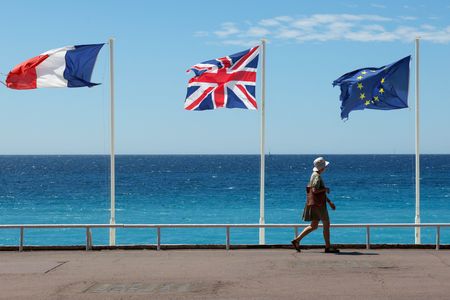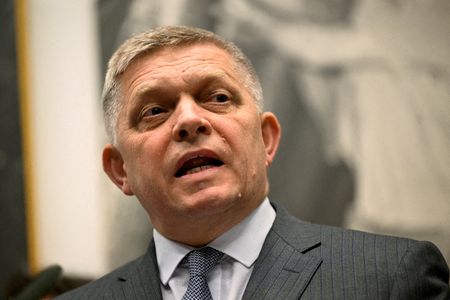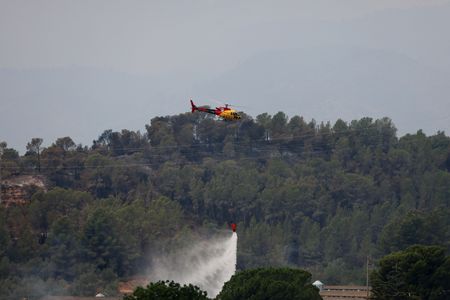CAIRO (Reuters) – In neighbourhoods levelled by 15 months of war with Israel, Hamas officials are overseeing the clearance of rubble in the wake of Sunday’s ceasefire. The group’s gunmen are guarding aid convoys on Gaza’s dusty roads, and its blue-uniformed police once again patrol city streets, sending a clear message: Hamas remains in charge.
Israeli officials have described a parade of jubilant Hamas fighters that celebrated the ceasefire on Sunday in front of cheering crowds as a carefully orchestrated attempt to exaggerate the Palestinian militant group’s strength.
But, in the days since the ceasefire took effect, Gaza’s Hamas-run administration has moved quickly to reimpose security, to curb looting, and to start restoring basic services to parts of the enclave, swathes of which have been reduced to wasteland by the Israeli offensive.
Reuters spoke to more than a dozen residents, officials, regional diplomats and security experts who said that, despite Israel’s vow to destroy it, Hamas remains deeply entrenched in Gaza and its hold on power represents a challenge to implementing a permanent ceasefire.
The Islamist group not only controls Gaza’s security forces, but its administrators run ministries and government agencies, paying salaries for employees and coordinating with international NGOs, they said.
On Tuesday, its police and gunmen – who for months were kept off the streets by Israeli airstrikes – were stationed in neighbourhoods through the Strip.
“We want to prevent any kind of security vacuum,” said Ismail Al-Thawabta, director of the Hamas-run Gaza government media office. He said that some 700 police were protecting aid convoys and not a single truck had been looted since Sunday – a contrast to the massive theft of food by criminal gangs during the conflict.
A spokesperson for the United Nations in Geneva confirmed on Tuesday there had been no reports of looting or attacks on aid workers since the ceasefire took effect.
In recent weeks, Israeli airstrikes have targeted lower-ranking administrators in Gaza, in an apparent bid to break Hamas’ grip on government. Israel had already eliminated Hamas’ leadership, including political chief Ismail Haniyeh and the architects of the Oct. 7 attack, Yahya Sinwar and Mohammed Deif.
Despite the losses, Al-Thawabta said the Hamas-run administration continued to function. “Currently, we have 18,000 employees working daily to provide services to citizens,” he said.
The Hamas-run municipalities had begun on Sunday clearing the rubble from some roads to allow vehicles to pass, while workers repaired pipes and infrastructure to restore running water to neighbourhoods. On Tuesday, dozens of heavy trucks ferried debris from destroyed buildings along the enclave’s dusty main arteries.
Israeli Prime Minister Benjamin Netanyahu has not articulated a vision for Gaza’s postwar future beyond insisting the Islamist group can play no role and stating that the Palestinian Authority – a body set up under the Oslo peace accords three decades ago that partially administers the occupied West Bank – also cannot be trusted under its current leadership. The Israeli government did not respond to Reuters’ questions.
Joost Hiltermann, of the International Crisis Group, said Hamas’ firm grip on Gaza presented Israel with a dilemma.
“Israel has a choice, to continue fighting in the future and killing people – and that hasn’t worked in the past 15 months – or it can allow an arrangement where the Palestinian Authority takes control with Hamas’ acquiescence,” Hiltermann said.
Hamas’ military capability is hard to assess because its rocket arsenal remains hidden and many of its best trained fighters may have been killed, Hiltermann said, but it remains by far the dominant armed group in Gaza: “Nobody is talking about the PA taking over Gaza without Hamas’ consent.”
While senior Hamas officials have expressed support for a unity government, Mahmoud Abbas, the head of the Palestinian Authority and a longtime adversary of Hamas, has not given his assent. Abbas’s office and the Palestinian Authority did not respond to a request for comment.
FRESH NEGOTIATIONS
Under the terms of the ceasefire, Israel must withdraw its troops from central Gaza and permit the return of Palestinians to the north during an initial six-week phase, in which some hostages will be released. Starting from the 16th day of the ceasefire, the two sides should negotiate a second phase, expected to include a permanent ceasefire and the complete withdrawal of Israeli troops.
Reconstruction, expected to cost billions of dollars and last for years, would only begin in a third and final phase.
The deal has divided opinion in Israel. While there was widespread celebration of the return of the first three hostages on Sunday, many Israelis want to see Hamas destroyed for its Oct. 7, 2023 attack on Israel in which 1,200 people were killed and more than 250 taken hostage.
Even before the ceasefire took effect, members of Netanyahu’s cabinet said they favoured returning to war to remove Hamas from power, once hostages have returned home. Three far-right ministers resigned.
“There is no future of peace, stability and security for both sides if Hamas stays in power in the Gaza Strip,” Foreign Minister Gideon Saar said on Sunday.
A spokesman for Hamas’ armed wing, Abu Ubaida, told Reuters the militant group would honour the terms of the ceasefire and urged Israel to do the same.
Fifteen months of war have left Gaza a wasteland of rubble, bombed-out buildings and makeshift encampments, with hundreds of thousands of desperate people sheltering from the winter cold and living on whatever aid can reach them. More than 46,000 people have been killed, according to Palestinian health authorities.
The ceasefire deal calls for 600 trucks of aid per day to reach Gaza. Al-Thawabta, the spokesman for the Hamas-run administration, said it was liaising with UN bodies and international relief organizations about security for aid routes and warehouses, but the agencies were handling the distribution of aid.
A U.N. damage assessment released this month showed that just clearing away the more than 50 million tonnes of rubble left in the aftermath of Israel’s bombardment could take 21 years and cost up to $1.2 billion.
On Sunday, as Hamas’ security forces paraded on the streets, some residents had expressed pride that it had survived the onslaught.
“Name me one country that could withstand Israel’s war-machine for 15 months,” said Salah Abu Rezik, a 58-year-old factory worker. He praised Hamas for helping to distribute aid to hungry Gazans during the conflict and trying to enforce a measure of security.
“Hamas is an idea and you can’t kill an idea,” Abu Rezik said, predicting the group would rebuild.
Others voiced anger that Hamas’ Oct. 7, 2023 attack had brought destruction to Gaza.
“We had homes and hotels and restaurants. We had a life. Today we have nothing, so what kind of a victory is this?” said Ameen, 30, a Gaza City civil engineer, displaced in Khan Younis. “When the war stops, Hamas must not rule Gaza alone.”
NO RIVALS
Since 2007, when Hamas drove out the Palestinian Authority dominated by the rival faction Fatah after a brief civil war, it has crushed opposition in Gaza. Supported by funds from Iran, it built a feared security apparatus and a military organization based around a vast network of tunnels – much of which Israel says it destroyed during the war.
The Palestinian Authority still pays the wages of thousands of government employees in Gaza involved in health and education, who report to ministries in the West Bank, and it provides support to many families of Palestinians killed or jailed by Israel. While the Authority says it is the only body with the legitimacy to govern post-war Gaza, it has no presence in the enclave and little popular support, polls show.
Israel has floated tentative ideas for post-war Gaza, including coopting local clan leaders – a number of whom were immediately assassinated by Hamas – or using members of Gazan civil society with no militant ties to run the enclave. But none has gained any traction.
Key donors, including the United Arab Emirates and U.S. President Donald Trump’s new administration, have stressed that Hamas – which is designated as a terrorist organization by many Western countries – cannot remain in power in Gaza after the war.
Diplomats have been discussing models involving international peacekeepers, including one that would see the United Arab Emirates and the United States, along with other nations, temporarily overseeing governance, security and reconstruction of Gaza until a reformed Palestinian Authority is able to take charge.
Another model, supported by Egypt, would see a joint committee made up of both Fatah and Hamas run Gaza under the supervision of the Palestinian Authority.
Michael Milshtein, a former Israeli military intelligence officer now at the Moshe Dayan Center for Middle Eastern and African Studies in Tel Aviv, described Hamas’ public willingness to discuss a unity government as “cosmetic”.
“As long as they are behind the scenes, handling matters, they don’t care that there will be a committee as a front,” he said.
On Monday, shortly after taking office, Trump expressed skepticism about the Gaza ceasefire deal, when asked if he was confident that all three phases of the agreement would be implemented. He didn’t elaborate further.
A spokesperson for the Trump camp did not respond to a request for comment.
(Additional reporting by Maayan Lubell and James Mackenzie in Jerusalem, and David Gauthier-Villars; editing by Daniel Flynn)















